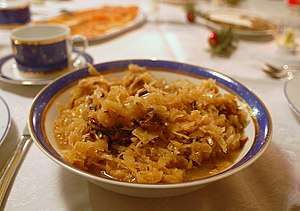Cabbage stew

Cabbage stew is a stew prepared using cabbage as a primary ingredient. Basic preparations of the dish use cabbage, various vegetables such as onion, carrot and celery, and vegetable stock.[1] Additional ingredients can include meats such as pork, sausage and beef, potatoes, noodles, diced apples, apple juice, chicken broth, herbs and spices, salt and pepper.[1][2][3][4][5]
In cuisines
Cabbage stew is a part of Austrian cuisine, whereby it is prepared using pork as an ingredient.[2]
Bigos is a dish in Polish cuisine of finely chopped meat of various kinds stewed with sauerkraut and shredded fresh cabbage. The dish is also traditional for Belarusian, Ukrainian and Lithuanian cuisine.[6][7]
Kapuska is a traditional cabbage stew in Turkish cuisine.[8][9] Its name is derived from the Russian language word for cabbage.
Kapusta kiszona duszona is a Polish dish consisting of sauerkraut or cabbage, bacon, mushroom and onion or garlic.
Potée is a term in French cuisine that refers to foods prepared in an earthenware pot. More specifically, it refers to a soup or stew made of pork and vegetables, most frequently, cabbage and potatoes of which choucroute is the most characteristic.[10]
.jpg) Kaalilaatikko casserole
Kaalilaatikko casserole Kapuska with veal
Kapuska with veal

See also
- Cabbage soup
- Coleslaw
- Kaalilaatikko – a casserole in Finnish cuisine[11] prepared using cabbage and other ingredients
- List of cabbage dishes
- List of stews
References
- 1 2 Wright, L. (2017). The First Mess Cookbook: Vibrant Plant-Based Recipes to Eat Well Through the Seasons. Penguin Publishing Group. p. pt134. ISBN 978-0-698-40987-3. Retrieved March 11, 2017.
- 1 2 Wright, C. (2012). The Best Stews in the World: 300 Satisfying One-Dish Dinners, from Chilis and Gumbos to Curries and Cassoulet. Harvard Common Press. p. 166. ISBN 978-1-55832-747-4. Retrieved March 11, 2017.
- ↑ Better Homes and Gardens Biggest Book of Slow Cooker Recipes. Better Homes & Gardens Cooking. Wiley. 2002. p. 112. ISBN 978-0-696-21546-9. Retrieved March 11, 2017.
- ↑ Lo, K.H.C. (1976). Chinese cooking on next to nothing. Pantheon Books. p. 85. ISBN 978-0-394-73231-2. Retrieved March 11, 2017.
- ↑ "Beef and Cabbage Stew". Batali, Mario. The Chew.
- ↑ Szymanderska (2010), p. 517.
- ↑ Pokhlebkin (2004), p. 113.
- ↑ M. Sabri Koz (2002). Yemek kitabı: tarih, halkbilimi, edebiyat. Kitabevi. ISBN 978-975-7321-74-3.
- ↑ Anastasia M. Ashman (1 February 2006). Tales from the Expat Harem: Foreign Women in Modern Turkey. Seal Press. pp. 191–. ISBN 1-58005-330-0.
- ↑ Larousse Gastronomique (1961), Crown Publishers
(Translated from the French, Librairie Larousse, Paris (1938)) - ↑ Ojakangas, B.; Cushner, S. (2011). The Best Casserole Cookbook Ever. Chronicle Books LLC. p. 211. ISBN 978-1-4521-1035-6. Retrieved March 11, 2017.